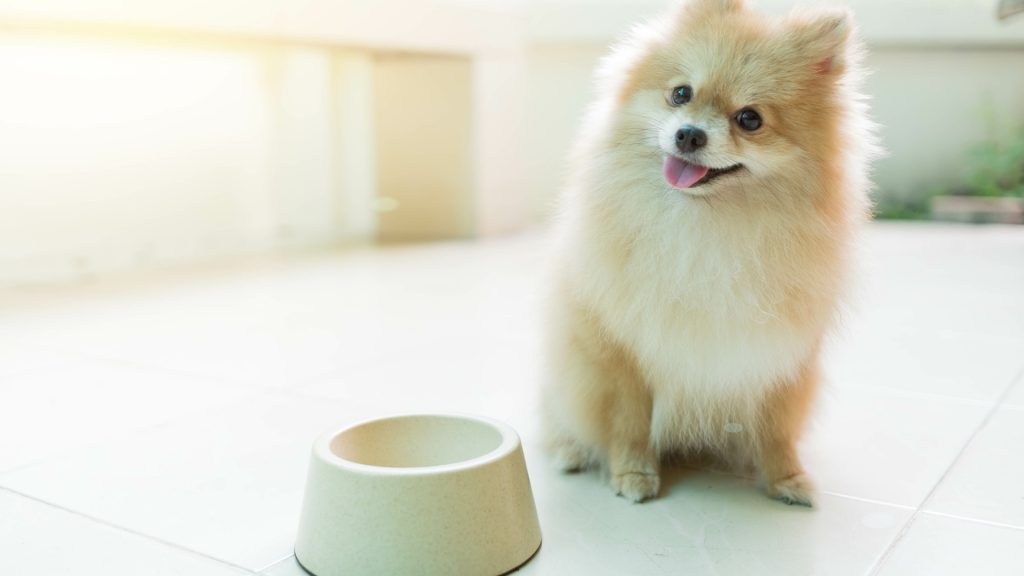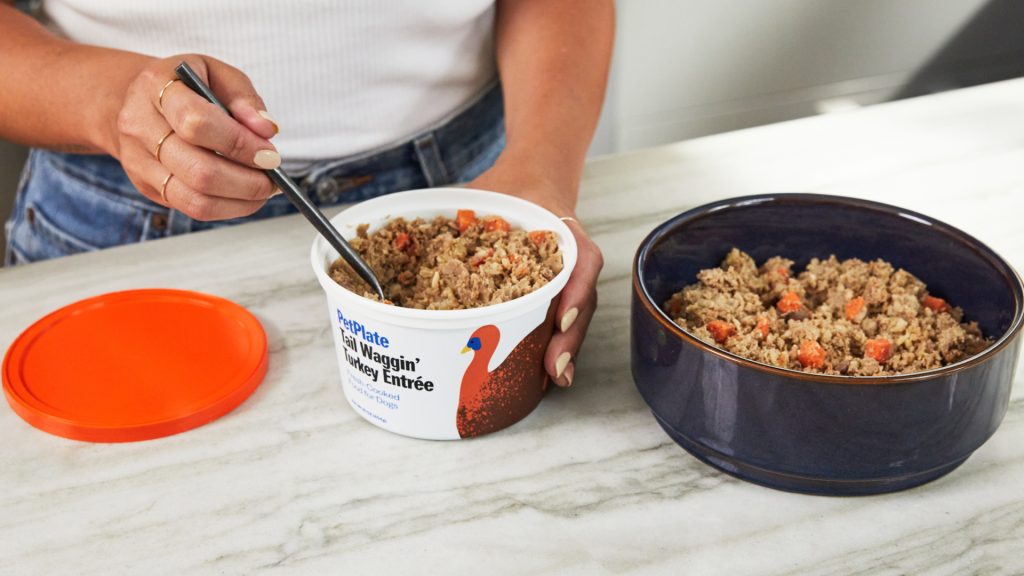A true extrovert of the animal world, Pomeranians — also known as Poms or Pom Poms — make a fantastic companion animal as well as a family pet. Their compact stature makes them a great breed for city dwellers, and they can be perfectly happy both galavanting around town and snoozing in your lap on a lazy afternoon. Plus, who wouldn’t love that adorable smiling face?
Fun fact: Did you know that Poms weren’t always tiny? Poms used to weigh about 30 pounds on average, making them ideal sled and herding dogs. In the 19th century, they were bred down to a smaller size to make them a better companion animal. You might still hear the term “Throwback Pomeranians” to describe Poms that are larger than today’s average of 5 to 10 pounds.
Ready to get to know your dog a little better? In this guide to Pomeranian diet and nutrition, you’ll learn the following:
- What is the Best Dog Food for Pomeranians & Pomeranian Puppies?
- How Much to Feed Pomeranians
- How Often to Feed Pomeranians
- Incorporating Training Treats into Your Pom’s Diet
- Common Health & Dietary Issues for Pomeranians
What is the Best Dog Food for Pomeranians & Pomeranian Puppies?

Pomeranians are part of the toy breed family—and much like the other breeds in this group, like Yorkies and chihuahuas, they tend to have big personalities for such little dogs. While their small stature doesn’t call for as much food as a larger breed requires, they are alert and quite active. You can support their fun-loving lifestyle with food that’s full of high-quality nutrients.
Here’s what to look for when you’re choosing your dog’s food:
- High-quality protein sources, like chicken, lamb, beef, or turkey
- Nutrient-dense ingredients, like flaxseed, turkey liver, and salmon oil (all great for supporting their gorgeous coat, too!)
You’ll also want to avoid any preservatives, additives, byproducts, or fillers in the food you’re serving. Many commercial dog food brands like to hide these, hoping you won’t notice!
If your Pom came from a breeder, make sure to chat with them about what they’ve been eating up until now. Same thing if you’ve adopted your Pom from a rescue—the agency or foster parent can tell you what kind of dog food they’ve been serving. If you’d prefer to switch to a different type, make sure you understand how to transition your dog’s food safely.
Next, you’ll need to understand how much to feed your Pom, to ensure they’re getting the right amount of calories for their size, age, and activity level.
How Much Should I Feed My Pomeranian?

So, how much should you feed your Pomeranian? Your veterinarian should always be your first resource for answering this question, as the amount will vary depending on age, weight, and other factors. However, a general rule of thumb is about ½ cup of high-quality dog food per pound of weight. This will be your total for the day, so it should be spaced out between feedings.
Consider the general guidelines in the following feeding chart:
| Weight | Feeding Amount (per day) |
| 3 pounds | ¾ to 1 ½ cups |
| 5 pounds | 1 ¼ to 2 ½ cups |
| 7 pounds | 1 ¾ to 3 ½ cups |
| 9 pounds | 2 ¼ to 4 ½ cups |
How do you know if you’re feeding your Pom enough? Keeping an eye on their weight is an easy way to check. As long as they’re maintaining their weight, you’re likely in a good spot.
Keep in mind that Pom Poms are prone to becoming overweight because of their small size, so keep an eye on this and continue working with your vet to refine the amount as they get older or if their lifestyle or activity level changes. Once they hit their senior years (8+), especially, they may need a bit less food as their metabolism slows down. (Tip: check out our senior dog food suggestions here!)
How Often Should I Feed My Pomeranian?
Next, how often should you feed your Pom pup? Although you might assume they need very little throughout the day to keep their tiny bodies moving, smaller dogs actually need to eat more often than their larger counterparts. Because they burn calories quickly, many experts recommend feeding Pomeranians three times per day. Pomeranian puppies should get even more, at up to four meals per day.
Consider these guidelines for your feeding schedule:
- Pomeranian puppies: aim to feed four times per day, spaced evenly throughout the day; for example, you could feed your dog in the morning, around noon, early evening, and then later in the evening
- Adult Pomeranians (1 year or older): aim for three meals, again spaced out throughout the day
Similar to humans, dogs can also develop certain preferences. For example, some dogs love a big, hearty breakfast, while others prefer a big dinner. Either is fine!
Incorporating Training Treats into Your Pom’s Diet
While Poms are very lovable and lively, that doesn’t mean they’re perfect angels. Pomeranians are known for being territorial and even a bit cocky, which often translates to unwanted yapping and barking. Introducing training at an early age (or whenever you’re able to) can go a long way in combating these behaviors.
Using dog treats as part of your obedience training can work well, but remember to adjust your dog’s other meals accordingly if you’re training often throughout the day. Those extra calories can add up! Consider offering a healthy treat, like PetPlate’s 100% Organic Chicken Apple Sausage Bites for a punch of extra nutrients. They’re soft and easy to break apart for training, as well as made with 100% human-grade ingredients in a USDA kitchen, following the same safety standards used to make human food.
Diet-Related Health Issues in Pomeranian

Of course, it’s important to consider what you’re feeding your pup, too. Feeding them healthy, fresh-cooked food each day may reduce your dog’s chances of experiencing any health issues in the future. And while Poms are generally a healthy breed, there are some common concerns you’ll need to know about. In the sections below, we’ll outline some of these issues to keep in mind when it comes to the Pomeranian breed.
Patella Luxation
Patella luxation, or “slipping kneecaps,” is one of the most common Pomeranian health issues. Small dogs are very susceptible to joint problems like this, as their small frame has to take on a lot. Serving a balanced diet and keeping their environment safe from slips and falls—no jumping off the bed or couch!—are some of the ways you can help your pup.
Tip: Ask your breeder for information on your specific dog, as they’ll typically “grade” the puppy’s knees at an early age. If yours received a higher grade, this can indicate that they may have additional problems and may even need surgery when they get older.
Obesity and Diabetes
Because they’re so small, even an extra ½ pound can make a big difference on your Pomeranian. And as pet parents, it can be all too easy to overfeed if you’re not paying attention.
As we mentioned earlier, the average weight for a Pomeranian is about 4-10 pounds. If you’re worried about your pup’s weight, be sure to talk to your veterinarian. If they’re at a good weight, maintain it by paying attention to portion sizes (including any extra treats!), keeping up with adequate exercise, and serving healthy and nutrient-rich food.
Hypoglycemia
Hypoglycemia, or low blood sugar, is a common health condition for smaller dogs. This is mainly because their metabolism is so fast! If you notice your Pom is acting lethargic, make an appointment to talk to your vet. Other symptoms include an upset stomach, lack of appetite, and discoloration of skin and gums. To avoid it, feed your dog at regular intervals throughout the day, never letting him go too long without eating.
Heart Conditions
Toy breeds are also susceptible to various heart conditions, which can range in intensity. Your vet will listen for any abnormal heart rhythms during your exams, as early detection is key. Along with those regular vet visits, keep your Pom healthy by encouraging a healthy lifestyle and—you guessed it—feeding a healthy diet! If your Pomeranian is diagnosed with heart disease or heart failure, you may need to switch to a diet that restricts sodium or add in extra supplements. As always, speak to your vet to understand your pet’s specific needs.
Hair Loss
Pom Poms are known for their gorgeous coats, but you’ll need to keep an eye on it for issues like Severe Hair Loss Syndrome (SHLS). With this syndrome, you may notice your dog’s hair thinning or the skin pigment underneath the hair changing. It’s typically found in male dogs, usually later in life. As with other conditions, early detection is important—so keep up with the regular brushing and grooming.
So, What is the Best Diet for a Pomeranian?

Your Pomeranian’s ideal meal plan will be one that is high-quality and high in essential nutrients, all to perfectly support their adventure-loving nature. And with PetPlate, you get all that and more. Our meals are made with 100% human-grade ingredients and kettle-cooked in a USDA kitchen, following the same safety standards used to make human food. Plus, we deliver right to your doorstep—cutting out the time you’d normally spend cooking or shopping. No fuss, no errands, and no extra dishes to wash.
Ready to give us a try? Tell us about your dog and we’ll put together a customized meal plan just for you. Start today and discover the ease and convenience of delicious, nutritious PetPlate meals.